
In the very first moment,
The development of the light bulb was marked by intense competition, as well as a number of significant setbacks and triumphs. Some people consider the electric light bulb to be the most significant invention made by humans since the creation of fire. The light bulb made it possible for us to work well into the night, navigate safely in the dark, and establish social order after the sun went down. It also extended the length of the workday. There would be no nightlife if there were no light bulbs to illuminate the world. However, despite what is suggested in many historical textbooks, developing a reliable and cost-effective source of illumination was not a simple task. The modern light bulb is the result of the work of a large number of innovators as well as ongoing improvements made over a period of 150 years.
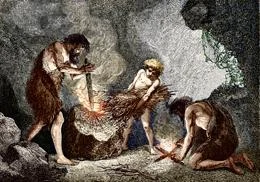
1700s
The Earliest Examples of Man-Made Light Sources People used a wide variety of strategies prior to the invention of electric lighting to get around their neighborhoods safely when it was dark out. In the region known as The Downs, which is close to the English Channel, there is a landscape that is characterized by patches of chalky soil that were used as lanterns. In places that had a lot of trees, the bark was peeled back in order to get at the lighter wood that was underneath. On the other hand, the moonlight and starlight were bright enough to navigate by during the majority of clear nights. During the 18th century, candles and oil lamps were the primary sources of illumination for many light fixtures in the majority of homes and businesses. These early sources of illumination produced a dim light, smoked, and released offensive odors as they worked. They were also perilous and demanded constant attention from the user. Candles made of beeswax and spermaceti were commonly used by wealthy aristocrats to illuminate the lavish homes in which they lived. The poorly used rushlights, which were makeshift candles made from reeds dipped in animal or vegetable fat and ignited; these rushlights only burned for a short period of time. The middle class used inexpensive tallow candles.
The development of lighting from its earliest forms into its most contemporary forms
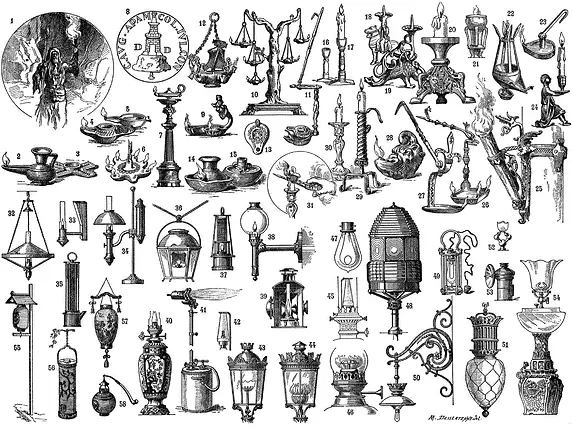
1800s
In many homes, businesses, and streets during the 19th century, gas lighting took the place of earlier forms of illumination such as candles and oil lamps. Gas lamps produced an illumination that was both brighter and more efficient. They also had a 75 percent lower operating cost than oil lamps or candles, in addition to being easier to use and safer. By the 1850s, gas lamps were used to illuminate the majority of the city streets in the United States and Europe. Gas lighting is credited with lowering crime rates and raising literacy levels in many different areas. When electricity became more accessible around the turn of the century, gas lamps were phased out in favor of incandescent lighting in public spaces such as streets, businesses, and theaters.
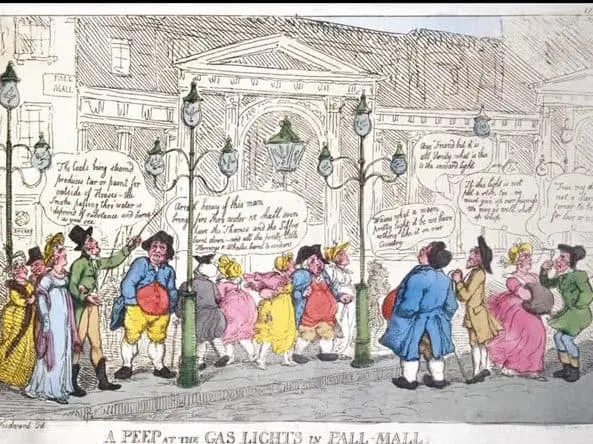
1802
The Very First Electrical Lamps By running an electric current through a thin strip of platinum in 1802, an English physician named Sir Humphry Davy invented the first electric light. The light did not remain for very long, but it was enough to mark the beginning of the history of light bulbs. At the Royal Institute in London in 1809, Davy gave a demonstration of the first carbon arc lamp. He did this by connecting two wires to a battery and affixing a charcoal strip in the middle of the wires that were connected to the battery. The scientific community as well as the general public were impressed with the demonstration. However, the arc lamp burned too brightly and consumed a large amount of current, which quickly depleted the battery and made it impractical for commercial development and production of the lamp. Arc lamps weren’t put to practical use in public spaces like streets and theaters until several decades after the invention of electric generators.
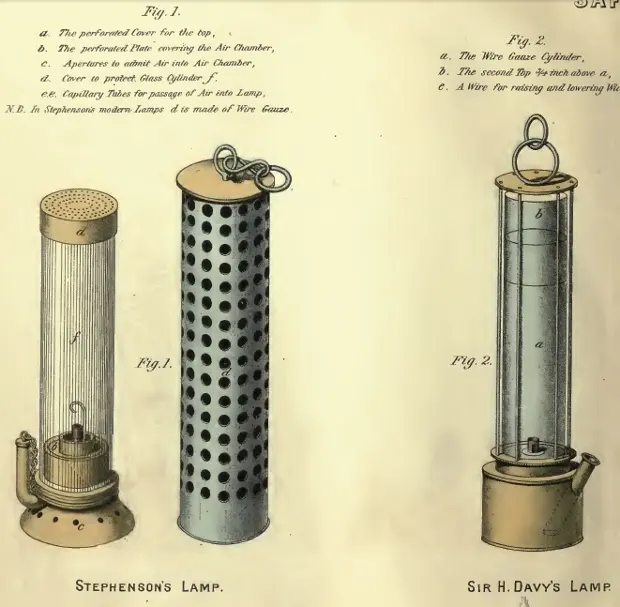
1875
Pavel Nikolayevich Yablochkov, a Russian electrical engineer and inventor, created the first practical arc lamp in the year 1875, which came to be known as the “Yablochkov Candle.” Yablochkov made use of two parallel carbon rods to extend the life of the battery. During the Paris World’s Fair of 1878, approximately 64 Yablochkov candles were installed on the Avenue de l’Opéra, Plade du Théatre Francais and around the Place de l’Opéra, earning the city the famous nickname of “City of Lights.” The success of the exhibition was influential in bringing electric lighting to the masses, and arc lamps were soon installed on many streets in the United States and Europe.
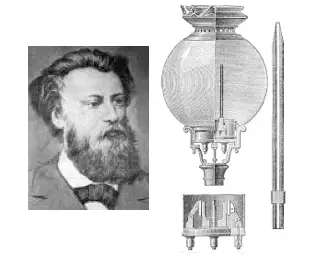
Arc lamps produced an intense, bright light that was ideal for illuminating streets and other outdoor spaces, but the dazzling lights were not suitable for use indoors, so they were not widely used for this purpose. In the latter half of the 1880s, inventors such as Thomas A. Edison and many others started experimenting with incandescent lamps in the hope of developing a method of indoor lighting that was both dependable and cost-effective. Before the development of short-arc lamps in the 1980s, arc lamps were utilized for a variety of high-intensity lighting applications, including searchlights, lighthouses, stadium lights, film production lights, and film projector lamps. However, these applications are no longer necessary. The Initial Applications of Incandescent Light Bulbs Incandescent light bulbs make use of electricity to warm a carbon or metal base filament that is housed within a glass bulb until it reaches a temperature at which it emits a radiant glow. A vacuum prevents the filament from burning up too quickly, which would otherwise leave the interior of the glass bulb blackened. The majority of the earliest incandescent light bulbs experienced the same difficulties, including a poor vacuum design, inferior and/or expensive filaments, and blackening of the bulb. Nevertheless, these early experiments were essential to the development of the first incandescent light bulb that was viable for commercial production.
1841
Frederick de Moleyns was awarded the very first patent for an incandescent lamp in England in the year 1841. To generate light, the lamp comprised a glass bulb, a vacuum chamber, and a layer of powdered charcoal in between two platinum filaments. Sadly, the lamp did not meet the requirements for use in a commercial setting. The vacuum had a poor design, which caused the light bulb to darken at the top, which blocked the light output. Platinum filaments were too expensive.
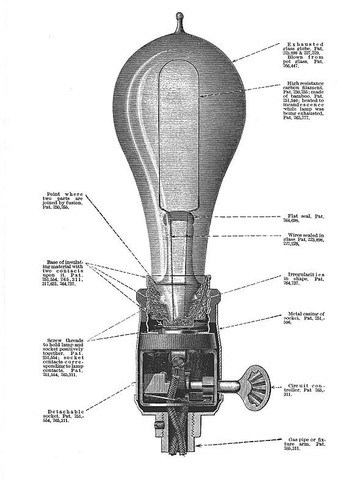
1865
Hermann Sprengel, a German chemist, invented a mercury-vacuum pump in 1865 and named it the Sprengel pump. This pump was able to remove air from a vacuum and gradually reduce pressure by pumping mercury through a reservoir, a T-junction, and a duct. Inventors who were working on incandescent lamps quickly adopted the invention because it helped to preserve the filament that was already contained within the bulb.

1874
Henry Woodward and Mathew Evans submitted a patent application in 1874 for an incandescent light bulb that contained a carbon filament in both Canada and the United States. Even though the light bulbs performed as expected, they did not sell very well. In the year 1879, they sold their patent to Thomas Edison.
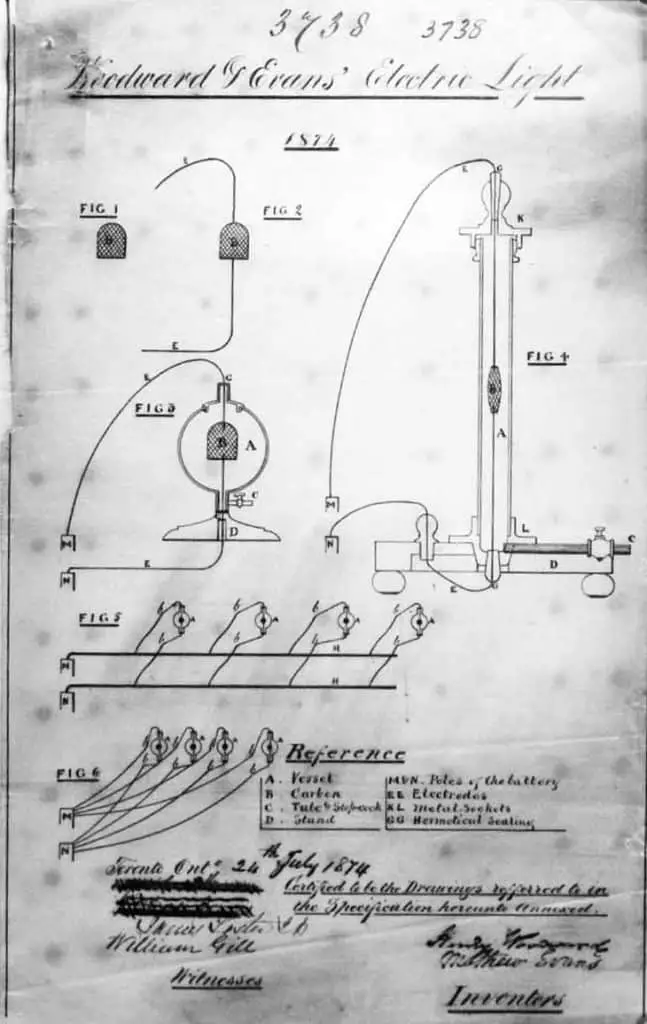
1878
The first patent in the United States for an “improvement of electric lights” was awarded to William E. Sawyer and Albion Man in 1878. The lamp that they patented consisted of a nitrogen-filled globe with a carbon conductor and was supported by large zigzagging radiators. Because of its rigid design, the lamp was prone to frequent breakage, which was caused by the carbon conductor’s inability to expand and contract normally. The incandescent lamps made by Sawyer-Man were the inspiration for the first light bulbs manufactured by Westinghouse.
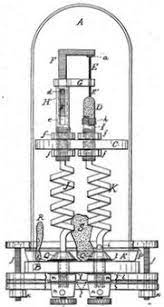
Edison and Swan Make a Play for the Title of “Inventor of the Incandescent Light Bulb.” Thomas A. Edison is given credit for being the sole inventor of the modern incandescent light bulb, despite the fact that 10,000 previous attempts had been made. Edison was not the only innovator vying to create the first commercially available incandescent light bulb; he was just the most successful. Innumerable chemists, physicists, and inventors competed for the prestigious award and lucrative financial reward. In the year 1878, a young man named Edison made the bold claim that he could produce an incandescent light that was superior in terms of safety, affordability, and dependability in just six weeks. The news sent shares of gas companies tumbling, causing the action. By the time he was 31 years old, Edison was known as the “Wizard of Menlo Park.” His innovations and inventions, which included the stock ticker, quadruplex telegraph, and phonograph, had earned him this nickname. In order to research and develop an incandescent light bulb, he obtained financial backing and put together a team in Menlo Park, New Jersey, consisting of 14 engineers, machinists, and physicists who were known as the “muckers.” Notable members of the team included Francis Upton, a mathematician and physicist from the United States; Charles Batchelor, also from the United States; and John Kruesi, a machinist born in Switzerland.

During this time period, Edison and his team developed a number of prototypes for incandescent light bulbs. One of these prototypes was a lamp that had a platinum filament. This filament oxidized slowly and had a high melting point. In order to solve the issue that had plagued earlier inventors and caused the filament to overheat and burn out, he devised a regulating system that intermittently rerouted the current away from the filament in order to allow it to cool down. This solved the issue. Because the system was difficult to manufacture and operate, and because the light bulb itself would turn off every few minutes, it was impossible to imagine the lamp being used in a commercial setting. At the same time, English chemist and physicist Sir Joseph Wilson Swan was independently working on an incandescent light bulb with a carbon filament. Swan started working on the incandescent bulb thirty years earlier than that. However, similar to other early inventors, he did not have access to a dependable vacuum or an appropriate electric source, which prevented him from developing a light bulb that was actually usable. Late in the year 1878, he informed the Newcastle Chemical Society that he had developed a functioning incandescent lamp, and the following year, he was granted a patent in the United Kingdom for his invention. In February of 1879, Swan gave a lecture to the Newcastle Literary and Philosophical Society, during which he demonstrated a working lamp. His design for a lamp consisted of an encased bulb in which the air had been removed, platinum lead wires, and a light-emitting carbon element.
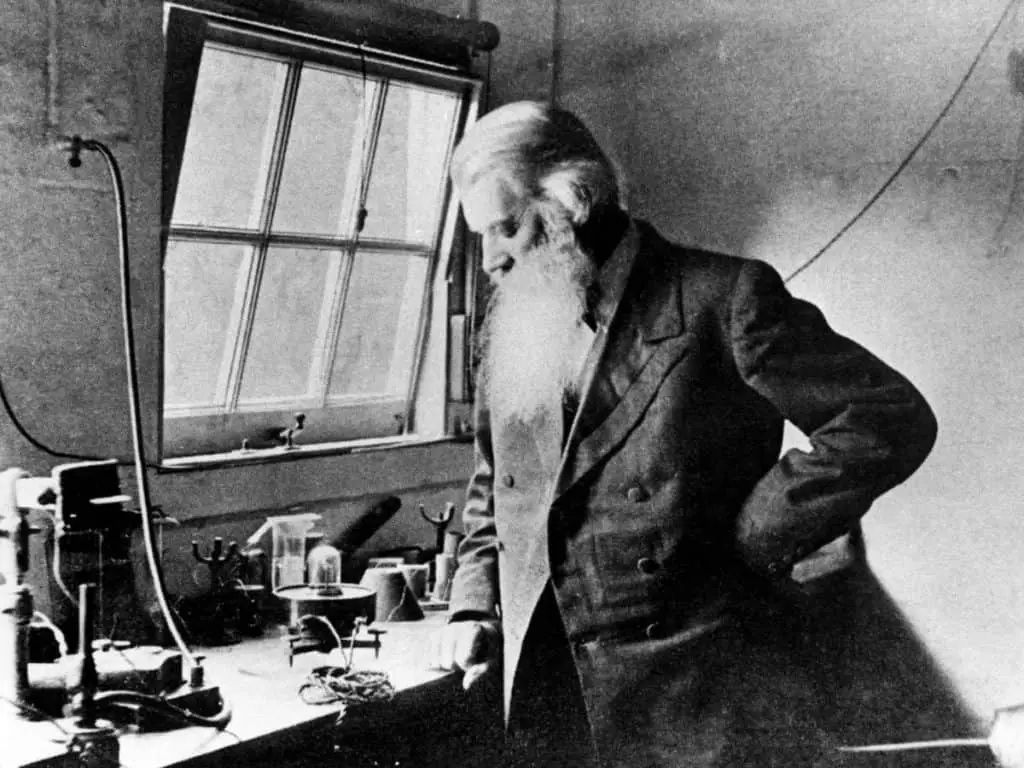
Even though it worked, Swan’s first incandescent lamp was not very well suited for use in the real world. Because the carbon rod had low electrical resistance and required a significant amount of current to heat up and make the filament glow, the electric conductors leading to the lamp either needed to be extremely short or excessively thick. When the lamp was turned on, the rod also let off gases, and quickly after, dark soot accumulated inside the glass, which blocked the lamp’s ability to emit light. After refining his original design, Swan went on to found his own electric lighting business, The Swan Electric Light Company, in the year 1881.
1879
Edison and his team made the discovery in 1879 that an extremely thin filament with a high electrical resistance was more productive. Because of this, the amount of current that was required to make the filament glow was relatively low, and the copper cables that were used were of a suitable size. Carbonized filaments made from baywood, boxwood, cedar, cotton, hickory, and flax were also tested by the team. Edison gave a presentation about his new invention on the evening of December 31 at Menlo Park in front of 3,000 guests.
1880
In the year 1880, Edison’s team made improvements to the light bulb by adding a bamboo filament that could remain lit for 1,200 hours. The filament made of carbonized bamboo eventually became the industry standard and was used for the following ten years. In the same year, Edison was awarded a second patent for the incandescent light bulb by the United States. Demonstrations of the new incandescent lamps were given at the Edison Electric Light Company’s laboratory in Menlo Park, and representatives of the company participated in trade shows and expositions across the country to further promote the lamps. The purpose of the demonstrations was to make people think of Edision whenever they heard about the new lighting technology. During this time, Edison initiated legal action against Swan in response to mutual allegations that each party had infringed upon the other’s patents. As a result of his defeat, he was compelled to make Swan a business partner in the British electric company in order to appease Swan. After a merger with The Swan Electric Company in 1883, the Edison Electric Light Company, Ltd. became known as the Edison and Swan United Electric Light Company, Ltd. (commonly known as Ediswan). After a few years of working together, Edison eventually bought Swan out of the company. Posters and advertisements showcasing Edison’s updated iteration of the incandescent light bulb Thomas Edison did not invent the light bulb; however, he did improve the design and performance of the earliest incandescent lamps in order to create the first light bulb that was viable for commercial production. In addition to this, he developed other inventions that made the light bulb suitable for use in everyday life. Edison Screw, a system of screw mounts that ensures compatibility between a light bulb and the base of a light fixture; and a complete electrical lighting system (including feeders, switches, and meters) not only capitalized on his light bulb design, but it also made him a household name and secured his name in the history books.
1911
For many years after his invention, the light bulb did not undergo any significant changes. William D. Coolidge, an American physicist working at General Electric (GE), developed tungsten filaments in 1911. These filaments burned brighter and lasted longer than carbon filaments did. The carbonized bamboo filaments in GE’s light bulbs were replaced with filaments made of tungsten, and the company’s bulb-making equipment underwent a complete overhaul. Irving Langmuir, an American chemist and physicist, made the discovery in 1913 that extending the life of tungsten filaments in light bulbs could be accomplished by filling the bulb with an inert gas such as nitrogen and twisting the filaments. In 1925, an American chemist and inventor named Marvin Pipkin came up with the idea for the frosted incandescent light bulb. Pipkin was also responsible for the development of a silica coating process that helped diffuse light, reduce glare, and minimize the loss of light output.
img:Invention by Marvin Pipkin Relating to Incandescent Light Bulbs
1956
In 1959, General Electric was the company that first commercialized the halogen light bulb. These light bulbs, while an adaptation of incandescent light bulbs, reduced the uneven evaporation of the filament and darkening of the envelope by filling the lamp with halogen gas rather than an inert gas. This allowed for a more even distribution of light to be produced. Halogen bulbs not only lasted longer, with an average life of 1,500 hours, but they also consumed 15 percent less energy than incandescent bulbs. The inefficiency of modern incandescent bulbs has not changed despite the many upgrades that have been made over the years. An incandescent light bulb only manages to convert about ten percent of the electrical power that is fed into it into visible light. The remainder of the energy is released as heat.
1970s
The Need to Conserve Energy Drives the Development of Energy-Efficient Lighting The oil crisis that hit the United States in the 1970s sparked interest in alternative forms of energy and more energy-efficient residential lighting. Lighting engineers initially repurposed fluorescent light bulbs for use in residential settings. Although fluorescent lamps have been in use since the 1930s, the majority of their applications are in the commercial and industrial lighting sectors. In 1976, an engineer working for GE named Edward E. Hammer bent a fluorescent tube into the shape of a spiral, thereby inventing the first compact fluorescent light bulb (CFL). Initially, GE decided not to pursue the design because the machinery required for mass production of the light bulbs was prohibitively expensive at the time. The design became public, and shortly thereafter, competing manufacturers started producing the light bulb.
Innovation information and history pertaining to the Edward Hammer compact fluorescent light bulb
1980s
Beginning around the middle of the 1980s, consumers could purchase their very first compact fluorescent lamps for anywhere between $25 and $35. Because of its price, its size, and its performance, customers were hesitant to embrace the new lighting technology. The first generation of compact fluorescent lamps (CFLs) was large and cumbersome, making them unsuitable for many existing light fixtures. The light bulbs not only produced a dim illumination but also performed inconsistently. As a result of subsequent advancements in price, performance, and efficiency, compact fluorescent lamps (CFLs) have emerged as the lighting option of choice for homeowners and business owners who are concerned about their impact on the environment. These days, compact fluorescent light bulbs (CFLs) consume 75 percent less power than their incandescent predecessors. They also have a life expectancy of 10,000 hours, which is approximately ten times longer than the average life expectancy of an incandescent bulb, and they cost as little as $1.71 per bulb. LEDs are the Light of Tomorrow One of the lighting technologies that is expanding at the quickest rate right now is called a light emitting diode, or LED. LEDs, or light-emitting diodes, are a type of solid-state lighting that make use of semiconductors to convert electrical current into visible light. Because LEDs emit light in a particular direction, there is less of a need for reflectors and diffusers that can trap light and absorb the heat that is produced by a heat sink. LEDs also produce less heat. It was in 1961 when James R. While working at Texas Instruments, “Bob” Biard and Gary Pittman made the groundbreaking discovery that led to the creation of the first light-emitting diode (LED). Innovation information pertaining to James Biard and Gary Pittman’s light-emitting diode (LED) bulbs Nick Holonyak Jr. of GE invented the first visible red diode the year after he had done so. In 1972, M. The very first yellow diode was created by George Craford. Craford, who was Holonyak’s graduate student at the time, made improvements to the red diode and developed the red-orange diode. Within the same year, the violet diode was developed by Herbert Maruska and Jacques Pankove. Indicator lights and calculator displays first started using red diodes in the late 1970s, after the manufacturing process for these diodes was refined by various companies.
1990s
Light-emitting diodes were a primary research topic throughout the 1990s as scientists worked to improve the devices’ energy efficiency. The first bright blue light-emitting diode was created by Shuji Nakamura in 1993. This was the final component that was required to create bright white LED light. Shortly after that, scientists began experimenting with blue, red, and green diodes by coating them with phosphors in order to make them appear white. Shuji Nakamura is the inventor of a blue LED, which enables a bright white LED.
2000s
The first light bulbs with LED diodes appeared on store shelves in the early 2000s. The United States in 2008. The L Prize Competition, which is a competition designed to push the development of ultra-efficient solid-state lighting products, has been announced by the Department of Energy (DOE). Late in the year 2009, Philips Lighting North America entered its LED light bulb into the 60-watt replacement category of the competition. The United States Department of Energy has estimated that there were 971 million 60-watt incandescent light bulbs in use at that time. In 2011, Philips Lighting emerged victorious in the competitive competition for the 60-watt replacement category of the L Prize. The winning light bulb was reported to have a lifespan of more than 27 years and cost forty dollars. More than 85 percent of the price of LED bulbs has been slashed since 2008, making them a more wallet-friendly option for lighting homes, businesses, and public spaces. LED light bulbs reduce energy consumption by 80 percent, last 25 times longer than incandescent light bulbs, and are six to seven times more efficient than traditional incandescent light bulbs. In the United States in 2012, 49 million LED products were installed, which resulted in a savings of approximately $675 million in annual energy costs.
The Inheritance of the Contemporary Light Bulb
Not only did the invention of the modern light bulb change how people lived their lives at home and in the workplace, but it also shaped the growth of cities and sped up the pace of economic activity. In search of better job opportunities, a large number of people left rural areas and moved to urban centers. New employment opportunities and forms of entertainment were provided by late-night restaurants and businesses, as well as sporting events. The introduction of electric light bulbs resulted in the practice of shift work, which improved worker efficiency and ultimately led to higher levels of production. They also improved working conditions, got rid of the heat and pollution caused by gas lighting, and cut down on the potential for fires. In many cases, the decrease in insurance premiums more than made up for the cost of the electricity. Light bulbs also brought about a shift in the way that businesses marketed their wares to customers, which resulted in the proliferation of illuminated billboards and signs.

